Watching the Sun: 5 types of gadgets, from $ 5 to $ 5,000
Hi, Habr.
Oddly enough, but on Habré / Geektimes there were quite a few articles on astronomy, but there is practically not a single article about the observation of our brightest star. We fill in this gap and see how the Sun can be observed. After all, as you know, just like that, you can look at it in the telescope on the Sun 2 times - with your left and right eyes.

Let's see how to do it, so that it is both interesting and safe.
I read about this method when I was still a pioneer, and tested it on my own, using a pipe from spectacle glasses.

The method is suitable only for pipes of small diameter, and is not suitable for mirror telescopes, as their inner mirror may overheat. But if there is a small refractor available, and you need to show others, for example, a solar eclipse or the passage of Venus through the solar disk, then the method is quite good. If you wish, you can even purchase a special screen from the Geoptik company, which allows you to observe the projection with sufficient comfort:

The most budgetary and affordable way for observers to give more or less decent quality. For about $ 30-50 you can buy a film that looks like foil.
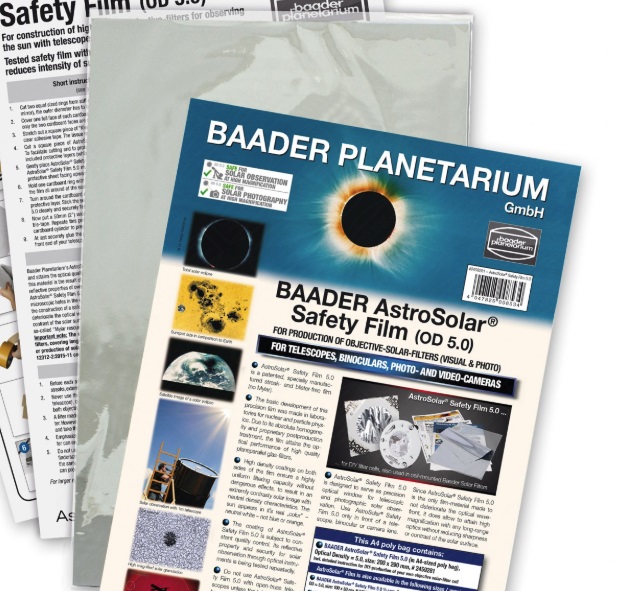
It can be cut into any size, and make adapters for any instrument, from a smartphone or theater binoculars to 10 "Dobson, from a Whatman and blue electrical tape. It can look something like this:

You can get a picture like this:

In real life, the increase will, of course, depend on the tool used, its aperture and magnification. The film itself, obviously, does not enlarge the image.
A small ready-made filter along with the housing can be bought in China for a few dollars, such a kit can be convenient, for example, for binoculars.

In fact, the method is not much different from the previous one, but a “collective farm” is not needed (this can be either a plus or a minus), and the picture quality is slightly better. The price of the issue, of course, is also higher, and ranges from $ 30 to $ 200, depending on the diameter and manufacturer.
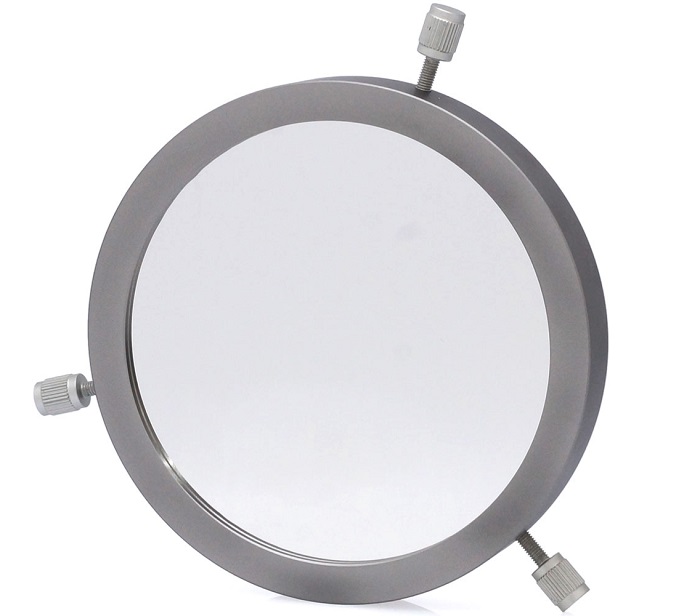
As is obvious from the photograph, this filter already needs to be selected for a specific pipe diameter.
Let's go further. If we want to observe even more details, we will need a special narrow-band filter . This filter passes only a narrow band of the light flux, and by the way, is the most expensive part in a specialized solar telescope. Let's see which models can be found on the market.
PST stands for Personal Solar Telescope, although in essence it is more like a spyglass than a telescope.
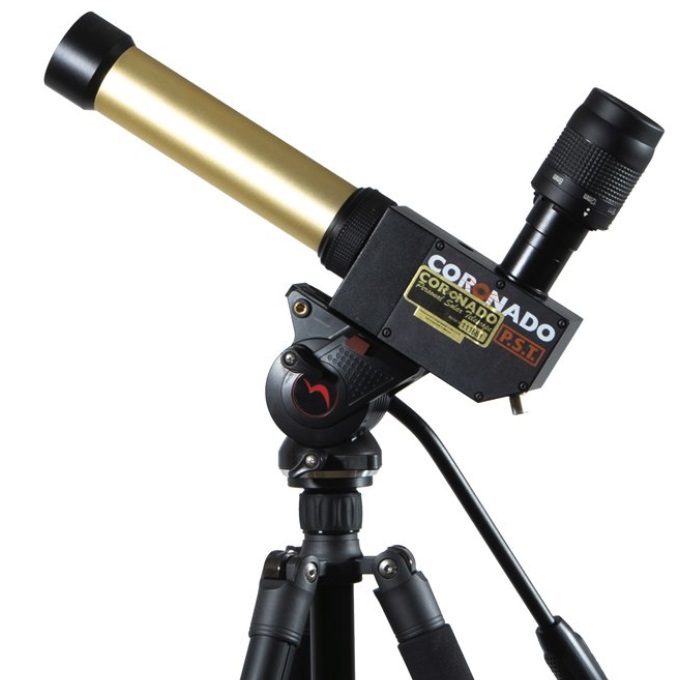
The focal length of the PST is only 400mm, and the aperture is 40mm, so you won’t have to count on large increases. The kit comes with an 18mm eyepiece, which gives an increase of only 22x. But the eyepieces can be changed, so if there are others, then the magnification can also be varied, the optimal range can be considered up to 8mm, which will give a 50-fold increase.
But the main plus of Coronado is, in fact, a narrow-band Ha filter, which allows you to observe much more details on the surface of the Sun, and also see solar prominences.
In real life, of course, we will not see such a detailed picture, as in the photo below, but you can understand the approximate idea of what is visible on the Sun through Ha:

And now about the sad - about the price. Coronado PST is sold in two versions, with a conventional (<1.0 Å) and a narrow (0.5 Å) filter. The second provides even better visual contrast, but the price of the device increases significantly. The “regular” Coronado PST costs Amazon $ 700, Coronado PST 0.5A costs $ 1,050, European prices can easily be multiplied by 1.5, I don’t know about Russian ones.
Of course, PST is only the initial level in observations of the Sun in Ha. And a 40mm aperture is of course very small. But narrow-band filters are really very expensive , and for example, such a 70mm telescope already costs 3000 Euro:
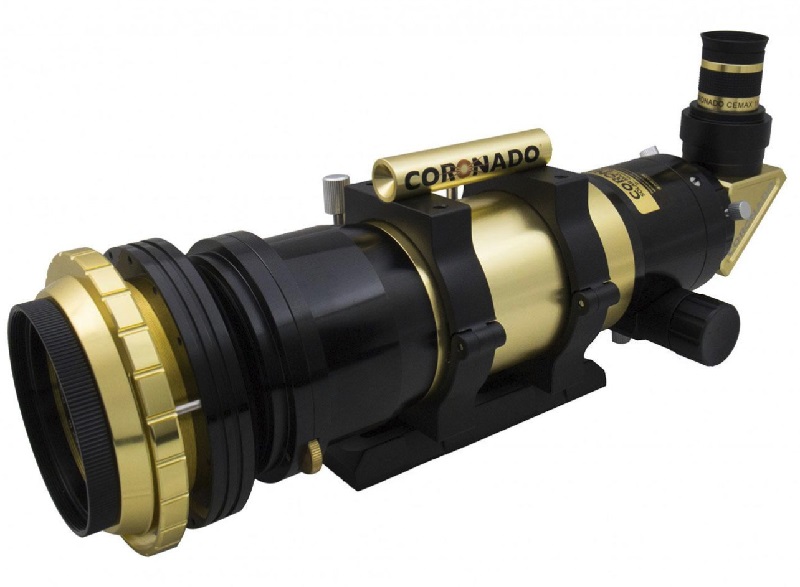
In addition to Coronado, Lunt telescopes are still quite interesting, they have a larger magnification than PST, but it is slightly cheaper. Some fans take filters from Coronado and combine them with optics from a conventional refractor, which allows you to get a larger aperture at a lower price, an example of such an alteration can be seen here .
Finally, if you do not want to be attached to one telescope of the same model, you can purchase a replaceable filter, for example, Daystar Quark:
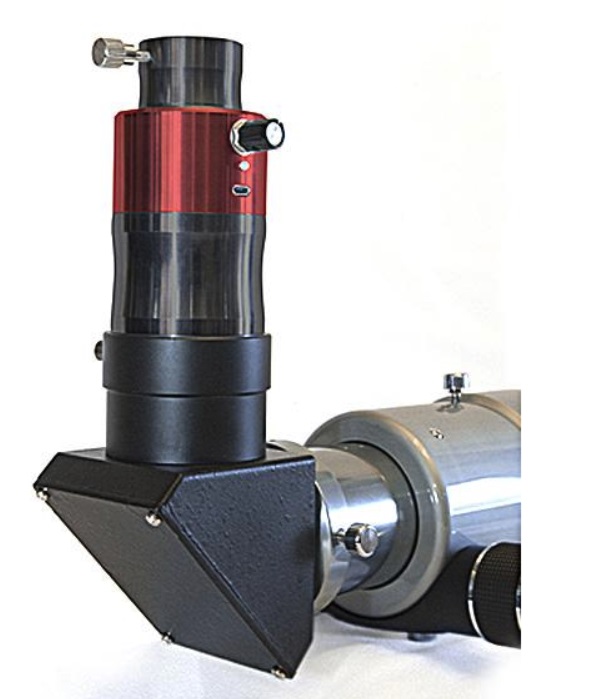
This filter (“only” for 1350 Euros) is placed on an existing refractor, turning it in this way into a solar one. It is interesting to note that there are filters on sale for different wavelengths - for the solar surface (Chromosphere) separately, for prominences (Prominences) separately. 1350 for each. No, I’m not scoffing, if you wish, you can buy a third one for calcium lines, for the same 1350.
All this can allow observing or photographing the Sun with approximately the following quality:
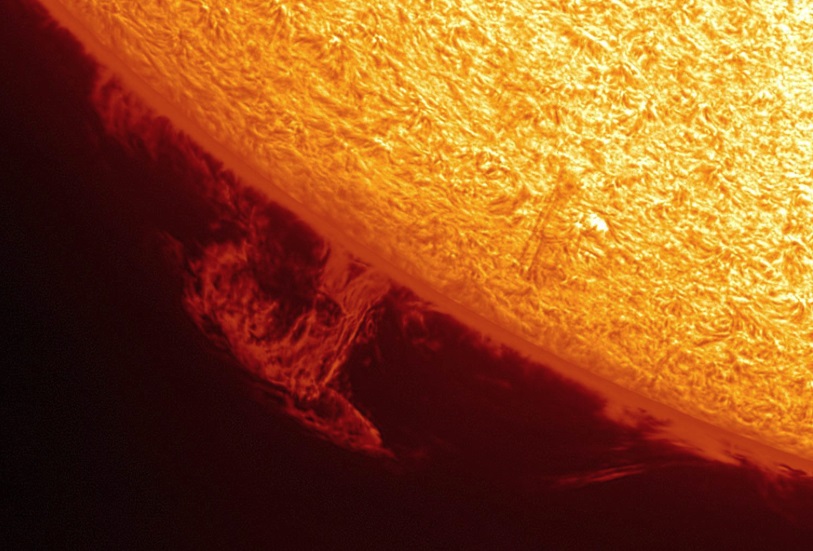
The upper price limit for different telescopes is not limited, there are Research Grade filters of the class for 10-15 kiloeuros, probably there are more expensive ones, but in ordinary prices they can no longer be found.
Observation of the Sun is a rather interesting process, unlike, for example, the Moon, frozen for thousands of years, its surface and structure are constantly changing. Yes, this is not cheap, but on the other hand, the price of a budget solar telescope is approximately equal to the price of an iPhone, so if you wish, you can afford it. And I’m sure that there will be more pleasure from the process than from Yablodevays (but who will surprise them at all now;), at least in terms of novelty and new impressions.
Several reviews (in English) of different models are given under the spoiler.
All successful observations.
Oddly enough, but on Habré / Geektimes there were quite a few articles on astronomy, but there is practically not a single article about the observation of our brightest star. We fill in this gap and see how the Sun can be observed. After all, as you know, just like that, you can look at it in the telescope on the Sun 2 times - with your left and right eyes.

Let's see how to do it, so that it is both interesting and safe.
1. Projection screen
I read about this method when I was still a pioneer, and tested it on my own, using a pipe from spectacle glasses.

The method is suitable only for pipes of small diameter, and is not suitable for mirror telescopes, as their inner mirror may overheat. But if there is a small refractor available, and you need to show others, for example, a solar eclipse or the passage of Venus through the solar disk, then the method is quite good. If you wish, you can even purchase a special screen from the Geoptik company, which allows you to observe the projection with sufficient comfort:

2. Baader Planetarium Astrosolar Film
The most budgetary and affordable way for observers to give more or less decent quality. For about $ 30-50 you can buy a film that looks like foil.

It can be cut into any size, and make adapters for any instrument, from a smartphone or theater binoculars to 10 "Dobson, from a Whatman and blue electrical tape. It can look something like this:

You can get a picture like this:

In real life, the increase will, of course, depend on the tool used, its aperture and magnification. The film itself, obviously, does not enlarge the image.
A small ready-made filter along with the housing can be bought in China for a few dollars, such a kit can be convenient, for example, for binoculars.

3. Glass filter
In fact, the method is not much different from the previous one, but a “collective farm” is not needed (this can be either a plus or a minus), and the picture quality is slightly better. The price of the issue, of course, is also higher, and ranges from $ 30 to $ 200, depending on the diameter and manufacturer.

As is obvious from the photograph, this filter already needs to be selected for a specific pipe diameter.
Let's go further. If we want to observe even more details, we will need a special narrow-band filter . This filter passes only a narrow band of the light flux, and by the way, is the most expensive part in a specialized solar telescope. Let's see which models can be found on the market.
4. Coronado PST telescopes
PST stands for Personal Solar Telescope, although in essence it is more like a spyglass than a telescope.

The focal length of the PST is only 400mm, and the aperture is 40mm, so you won’t have to count on large increases. The kit comes with an 18mm eyepiece, which gives an increase of only 22x. But the eyepieces can be changed, so if there are others, then the magnification can also be varied, the optimal range can be considered up to 8mm, which will give a 50-fold increase.
But the main plus of Coronado is, in fact, a narrow-band Ha filter, which allows you to observe much more details on the surface of the Sun, and also see solar prominences.
In real life, of course, we will not see such a detailed picture, as in the photo below, but you can understand the approximate idea of what is visible on the Sun through Ha:

And now about the sad - about the price. Coronado PST is sold in two versions, with a conventional (<1.0 Å) and a narrow (0.5 Å) filter. The second provides even better visual contrast, but the price of the device increases significantly. The “regular” Coronado PST costs Amazon $ 700, Coronado PST 0.5A costs $ 1,050, European prices can easily be multiplied by 1.5, I don’t know about Russian ones.
Of course, PST is only the initial level in observations of the Sun in Ha. And a 40mm aperture is of course very small. But narrow-band filters are really very expensive , and for example, such a 70mm telescope already costs 3000 Euro:

In addition to Coronado, Lunt telescopes are still quite interesting, they have a larger magnification than PST, but it is slightly cheaper. Some fans take filters from Coronado and combine them with optics from a conventional refractor, which allows you to get a larger aperture at a lower price, an example of such an alteration can be seen here .
5. Replaceable Ha Filters
Finally, if you do not want to be attached to one telescope of the same model, you can purchase a replaceable filter, for example, Daystar Quark:

This filter (“only” for 1350 Euros) is placed on an existing refractor, turning it in this way into a solar one. It is interesting to note that there are filters on sale for different wavelengths - for the solar surface (Chromosphere) separately, for prominences (Prominences) separately. 1350 for each. No, I’m not scoffing, if you wish, you can buy a third one for calcium lines, for the same 1350.
All this can allow observing or photographing the Sun with approximately the following quality:

The upper price limit for different telescopes is not limited, there are Research Grade filters of the class for 10-15 kiloeuros, probably there are more expensive ones, but in ordinary prices they can no longer be found.
Conclusion
Observation of the Sun is a rather interesting process, unlike, for example, the Moon, frozen for thousands of years, its surface and structure are constantly changing. Yes, this is not cheap, but on the other hand, the price of a budget solar telescope is approximately equal to the price of an iPhone, so if you wish, you can afford it. And I’m sure that there will be more pleasure from the process than from Yablodevays (but who will surprise them at all now;), at least in terms of novelty and new impressions.
Several reviews (in English) of different models are given under the spoiler.
Video
Solar Projection:
Baader Astrosolar:
Coronado:
Lunt:
Daystar Quark:
Baader Astrosolar:
Coronado:
Lunt:
Daystar Quark:
All successful observations.
All Articles